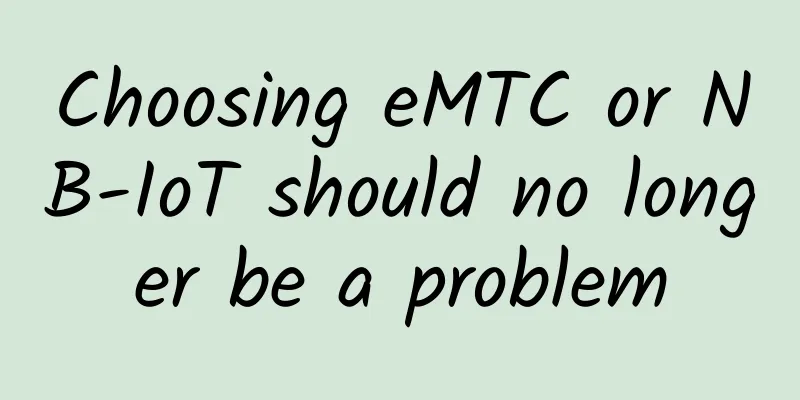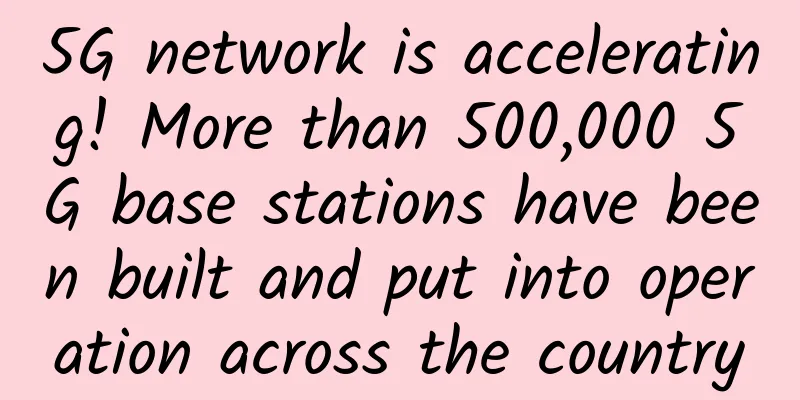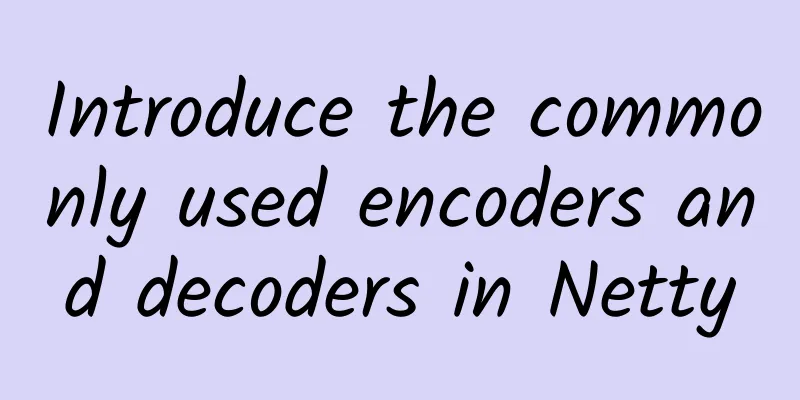Choosing eMTC or NB-IoT should no longer be a problem

|
For a long time, the two cellular Internet of Things standards, eMTC and NB-IOT, have been in competition with each other, and the industry has been arguing over which network standard should be chosen. This article analyzes the differences between the two at the technical level, their complementarity in application scenarios, and introduces the consensus reached by the industry at the 76th 3GPP Plenary Meeting on the evolution direction of mobile Internet of Things technology (including NB-IoT and eMTC) Rel.15. 1. Advantages of eMTC as a narrowband IoT As one of the mainstream network standards for narrowband cellular IoT, eMTC has the four basic capabilities of LPWA compared to non-cellular IoT: wide coverage, large connections, low power consumption, and low cost. Let's analyze them one by one: 1. Low power consumption and long terminal life. Currently, the standby time of 2G terminals is only about 20 days. In some typical LPWA applications such as meter reading services, 2G modules obviously cannot meet the application requirements of special locations such as deep wells and chimneys where batteries cannot be replaced. The power consumption of eMTC is only 1% of that of 2G Modem, and the terminal can be in standby for up to 10 years.
2. Massive connections to meet the needs of "big connection" applications. A major feature of IoT terminals is the massive connection of users. The current networks designed for non-IoT applications cannot meet the needs of simultaneous access to massive terminals, while eMTC supports more than 10,000 terminals per cell. 3. Inadequate network coverage in typical scenarios, such as deep wells, underground garages and other coverage blind spots, 4G outdoor base stations cannot achieve full coverage. In terms of wide coverage, eMTC is 15dB stronger than LTE (can penetrate one more wall) and 11dB stronger than GPRS, and the signal can cover 2-3 floors underground. 4. Costs are expected to continue to decrease. Currently, the mainstream communication technology for smart home applications is WiFi. Although the price of WiFi modules is relatively low, having dropped to less than RMB 10, IoT devices that support WiFi usually still require wireless routers or wireless APs for network access, or can only communicate in a local area network. 2G communication modules are generally more than RMB 20, while 4G communication modules are more than RMB 150. In comparison, eMTC terminals are expected to continue to reduce costs through cross-industry chain subsidies. 5. The dedicated frequency band has little transmission interference. Compared with non-cellular IoT technologies, eMTC is based on authorized spectrum transmission, has little transmission interference, better security, and can ensure reliable transmission. 2. Competition and Cooperation between eMTC and NB-IOT Back to the cellular Internet of Things, the two standards of the cellular Internet of Things, eMTC and NB-IOT, have been in a competitive relationship for a long time, and the industry has been arguing over which network standard should be chosen. In fact, both sides have their own technical advantages and a basis for cooperation. There is no perfect choice. In many cases, the competition is about whose module chip costs drop faster, whose commercialization is higher, and whose network construction is more complete. This debate officially came to an end in June 2017. At the 76th plenary meeting of 3GPP, the industry reached a consensus on the evolution direction of Rel.15 of mobile Internet of Things technology (including NB-IoT and eMTC): no new eMTC terminal types with system bandwidth lower than 1.4MHz will be added; no new NB-IoT terminal types with system bandwidth higher than 200KHz will be added. This resolution of 3GPP has promoted the orderly development of M-IoT, completely separated the application boundaries between eMTC and NB-IOT, and transformed them into a hybrid networking, differentiated and complementary cooperative relationship. Let's take a look at the differences between the two in terms of technology and application. 1. The relationship between the two from a technical perspective In terms of peak rate, NB-IoT has poor support for data rate, at 200Kbps, while eMTC can reach 1Mbps; in terms of mobility, NB-IoT has almost no mobility because it cannot achieve automatic cell switching, and eMTC performs better in mobility; in terms of voice, NB-IoT does not support voice transmission, while eMTC does; in terms of terminal cost, NB-IoT has now dropped to around US$5 due to the unified module and chip standards, but the current price of eMTC is still high and is declining slowly; in terms of cell capacity, eMTC has not been directional optimized and it is difficult to meet the connection requirements of ultra-large capacity; in terms of coverage, the coverage radius of NB-IoT is 30% larger than that of eMTC. The coverage of eMTC is about 9dB worse than that of NB-IoT. 2. Hybrid networking of the two from the application scenario From the technical features of both parties, we can see that NB-IoT has superior performance in terms of coverage, power consumption, cost, number of connections, etc., and is usually used in static scenarios that pursue lower costs, wider and deeper coverage, and longer battery life; eMTC is currently weaker than NB-IoT in terms of coverage and module costs, but it has advantages in peak rate, mobility, and voice capabilities, and is more suitable for use in scenarios with voice calls, high bandwidth rates, and mobile needs. In real market usage scenarios, the two parties can form a complementary relationship. According to forecast data, due to its low cost and wide coverage, the number of NB-IoT connections is 8:2 compared to eMTC. However, relatively speaking, the application scenarios under the eMTC network are richer, and the relationship between applications and people is more direct. The ARPU value of users in the eMTC network environment will be higher. In the "Mobile Internet of Things Industry Solution White Paper" released by China Mobile, it can be found that after NB-IoT/eMTC hybrid networking, the application scenarios will be richer. NB-IoT technology applications involve static scenarios, such as smart meter reading, smart switches, smart manhole covers, etc. However, after NB-IoT/eMTC hybrid networking, more interactive and collaborative IoT applications will be involved, such as full-process product management, smart parking, shared bicycles, financial leasing, cash box monitoring, smart greenhouses, animal traceability, forestry data collection, remote health, smart street lights, air monitoring, smart homes, etc. From the above, we can see that the simultaneous advancement of NB-IoT and eMTC can meet the comprehensive needs of solving multiple scenarios. From the viewpoints in this article, it can be seen that there is no relationship between NB-IoT and eMTC in which one is chosen and which is eliminated. Due to the different application scenarios of NB-IoT and eMTC, operators will choose to coordinate the two to jointly expand the industrial chain, continuously drive consumption upgrades, provide B-end manufacturers with more application scenarios that are not restricted by technology, improve the experience of C-end users, stimulate users' rigid demand, and lay the foundation for the integrated development of 5G and various industries. This is the future path of the integrated development of NB-IoT and eMTC. [This article is an original article by 51CTO columnist Wang Feng. Please contact the author for authorization if you want to reprint it.] Click here to read more articles by this author |
>>: The Internet of Identity is coming, and IAM will undergo a major change
Recommend
Only speed can keep you going! Explain the main features and advantages of Wi-Fi 6
The Wi-Fi industry is currently developing rapidl...
Wi-Fi 6 certification, here are 6 issues worth paying attention to!
This article is reproduced from Leiphone.com. If ...
Emergen research: By 2028, the global IoT chip market is expected to reach US$34.74 billion
March 16 news, recently, a report released by mar...
Inventory of URLError and HTTPError exception handling methods
[[390611]] 1. Introduction This article mainly ta...
User complaints have dropped significantly, so why can’t operators smile?
[[403552]] This article is reprinted from the WeC...
Cisco releases new developer capabilities for intent-based networking platform
Cisco today announced new developer capabilities ...
The intelligent world is waiting for you to build. Huawei Cloud joins hands with millions of developers to Login 2020
What does an intelligent world where everything i...
VMISS 20% off for all items, Korea/Japan/Hong Kong CN2/Los Angeles CN2 GIA/9929/CMIN2 etc. starting from 21 yuan/month
VMISS updated its promotional plan in December an...
spinservers New Year promotion: $39/month-E3-1280v5/32GB/1TB NVMe/30TB@10Gbps
spinservers has released several special packages...
AlphaVPS: Bulgaria dedicated servers from €34.99/month, VPS hosting from €15/year
AlphaVPS is a leading IaaS provider in Europe (DA...
Kai-Fu Lee: Under what conditions will artificial intelligence surpass humans?
[51CTO.com original article] In recent years, art...
Sharktech: High-security VPS with 50% off annual payment starting at $47.7/year - 2GB/40GB/4TB/Los Angeles & Denver multiple data centers
Sharktech is offering a 25% discount on quarterly...
iONcloud New Year 20% off, San Jose/Los Angeles/Dallas/Honolulu data centers, Linux/Windows options
iONcloud has released a special offer for the Yea...
China Broadcasting Corporation's 700MHz frequency migration bidding failed, and the road to 5G encountered another setback
The much anticipated China Radio and Television 7...
How to solve VirtualBox bridged networking problems?
【51CTO.com Quick Translation】Let's assume tha...









